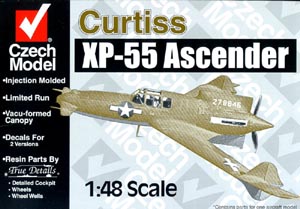 Czech
Model 1/48 XP-55 Ascender
Czech
Model 1/48 XP-55 Ascender
 Czech
Model 1/48 XP-55 Ascender
Czech
Model 1/48 XP-55 AscenderBy John Lester
Background
The year is 1939. The US Army Air Corps is just realizing that the newest fighter aircraft entering service, the P-35 and P-36, are nowhere near as capable as those soon to be battling over the skies of Europe. This leads the USAAC to call for a new generation of aircraft, based on what appear to be some radical requirements. These requirements would lead to quite a few novel designs, some of which were effective (Lockheed's P-38) and some of which were not (Curtiss-Wright's XP-55).
In late 1939, the USAAC issued a specification for a single-seat interceptor to be powered by a new Pratt & Whitney engine. The main requirements were for low drag, exceptional pilot visibility and powerful armament. Three manufacturers submitted designs in early 1940, and all three were awarded contracts to continue work, with options for constructing prototypes. The Curtiss-Wright CW-24 design was too advanced, however, and the Army lost interest. This forced the company to build a full-scale flying mockup, the CW-24B. After extensive flight testing, the Army's interest was sufficiently regained that a contract was awarded for three experimental prototypes. These were to be powered by Allison V-1710 engines (the same ones that powered the P-38, P-39 and P-40), as the P&W in-line had failed to develop.
The XP-55 "Ascender" (or "Ass-ender", as it was more commonly known at the time) was a radical departure from traditional aircraft design. It was designed to make use of the efficiencies of canard or "tail- first" designs, which make for lighter structures and thus (theoretically) better performance from the same powerplant. It had aft-mounted main wings swept sharply back, with ailerons, trailing edge flaps and vertical fins near the wing tips. Small foreplanes on the nose house the elevators. The all-metal fuselage housed the armament, cockpit and engine. The three-bladed propeller could be jettisoned in an emergency, so the pilot could bail out without being shredded. The plane also was the first one from this manufacturer to use retractable tricycle landing gear.
The XP-55 never lived up to the promise of the design. The first prototype crashed just six months after its July 1943 maiden flight. High wing loading and small control surfaces made low-speed handling hazardous, and though the second and third prototypes had extensive modifications to address these issues, they were never overcome. Even with longer wings and greater elevator travel, low speed handling characteristics were poor, and all-around performance well below that of contemporary fighters. The Army cancelled the program in 1944, but the two remaining prototypes continued flight testing until the third prototype crashed in 1945, killing the pilot and a passing motorist. The second prototype still exists in the collection of the National Air and Space Museum.
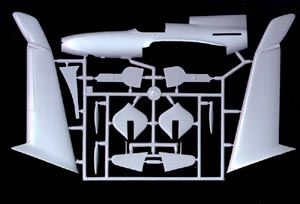 The
Kit
The
Kit
 The
Kit
The
Kit That someone has made an injection-molded kit of the XP-55 in 1/48 gives me hope that one day I'll see a Saab J-21 in the same scale. Squadron/ Czech Models have quickly built a reputation for providing decent kits of unique subjects, and the XP-55 is a welcome addition to their catalog. The parts and decals provided represent the second prototype as it appeared with all the modifications made throughout testing.
The kit is packed in the typical flimsy cardboard box and appears to be some of the best work the company has done yet. You get: two sprues of grey plastic in one bag; a pile of resin parts made by True Details in another bag; one vacuformed piece containing two canopies; instructions, and a small sheet of decals.
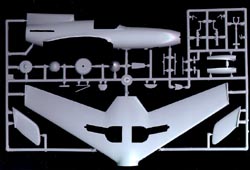 The
plastic sprues provide 35 or so parts, mostly for the airframe and landing
gear. There is a little flash and a few rough edges to clean up; the
gates holding the pieces to the parts tree are agreeably small, and
should not interfere much when removing the various bits. Detailing
consists almost exclusively as finely engraved lines, which are a little
bit soft, and all of uniform size/depth. I'll probably rescribe the
control surface lines to accentuate them. Landing gear door covers are
molded in the closed position, which makes doing an in-flight model
easier. The instructions show where to slice them to do the gear down.
The
plastic sprues provide 35 or so parts, mostly for the airframe and landing
gear. There is a little flash and a few rough edges to clean up; the
gates holding the pieces to the parts tree are agreeably small, and
should not interfere much when removing the various bits. Detailing
consists almost exclusively as finely engraved lines, which are a little
bit soft, and all of uniform size/depth. I'll probably rescribe the
control surface lines to accentuate them. Landing gear door covers are
molded in the closed position, which makes doing an in-flight model
easier. The instructions show where to slice them to do the gear down.
 The
plastic sprues provide 35 or so parts, mostly for the airframe and landing
gear. There is a little flash and a few rough edges to clean up; the
gates holding the pieces to the parts tree are agreeably small, and
should not interfere much when removing the various bits. Detailing
consists almost exclusively as finely engraved lines, which are a little
bit soft, and all of uniform size/depth. I'll probably rescribe the
control surface lines to accentuate them. Landing gear door covers are
molded in the closed position, which makes doing an in-flight model
easier. The instructions show where to slice them to do the gear down.
The
plastic sprues provide 35 or so parts, mostly for the airframe and landing
gear. There is a little flash and a few rough edges to clean up; the
gates holding the pieces to the parts tree are agreeably small, and
should not interfere much when removing the various bits. Detailing
consists almost exclusively as finely engraved lines, which are a little
bit soft, and all of uniform size/depth. I'll probably rescribe the
control surface lines to accentuate them. Landing gear door covers are
molded in the closed position, which makes doing an in-flight model
easier. The instructions show where to slice them to do the gear down.
The resin parts provide cockpit detailing, bulged and flattened wheels, wheel wells, and exhausts. The detail is sharp and crisp, and there appear to be no pits, bubbles or other flaws - in other words, typical True Details quality. All the parts are on large, thick pour stubs.
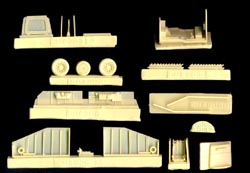 Two
vacuformed canopies are provided, which is much appreciated if, like
me, you're not terribly adept at cutting such things out right the first
time. The plastic is quite clear, and the detail sharp enough to make
painting the framing relatively easy. The canopies are molded in the
closed position, which means anyone wanting to show off that interior
detail has some careful surgery to do.
Two
vacuformed canopies are provided, which is much appreciated if, like
me, you're not terribly adept at cutting such things out right the first
time. The plastic is quite clear, and the detail sharp enough to make
painting the framing relatively easy. The canopies are molded in the
closed position, which means anyone wanting to show off that interior
detail has some careful surgery to do.
 Two
vacuformed canopies are provided, which is much appreciated if, like
me, you're not terribly adept at cutting such things out right the first
time. The plastic is quite clear, and the detail sharp enough to make
painting the framing relatively easy. The canopies are molded in the
closed position, which means anyone wanting to show off that interior
detail has some careful surgery to do.
Two
vacuformed canopies are provided, which is much appreciated if, like
me, you're not terribly adept at cutting such things out right the first
time. The plastic is quite clear, and the detail sharp enough to make
painting the framing relatively easy. The canopies are molded in the
closed position, which means anyone wanting to show off that interior
detail has some careful surgery to do. Decals give you the option of making the second prototype, despite what the box claims. They are crisp and perfectly registered. However, if they are like all the other Czech Model decals I've used, they are so thin they are easily torn, translucent, and the inks start to run under the influence of even the mildest setting solutions. You'll want to overcoat them with a layer of liquid decal film, at a minimum, to make them easier to handle and somewhat resistant to setting aids. Luckily, the paint scheme is pretty uniform, so the translucence should not be a big issue.
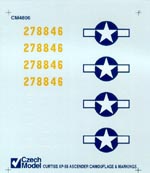 Rounding
out the package is a four page instruction sheet. The first page gives
a brief potted history and a handy diagram showing all the parts. Pages
2 and 3 are comprised of a 7-step pictorial assembly guide. The steps
are clearly illustrated and easy to follow. Notes point out where extra
details (like the throttle/mixture levels) will need to be made, or
how to get around tricky spots in the assembly (cockpit sidewalls).
The last page (as well as the back of the box) contains interior and
exterior painting and marking information.
Rounding
out the package is a four page instruction sheet. The first page gives
a brief potted history and a handy diagram showing all the parts. Pages
2 and 3 are comprised of a 7-step pictorial assembly guide. The steps
are clearly illustrated and easy to follow. Notes point out where extra
details (like the throttle/mixture levels) will need to be made, or
how to get around tricky spots in the assembly (cockpit sidewalls).
The last page (as well as the back of the box) contains interior and
exterior painting and marking information.
 Rounding
out the package is a four page instruction sheet. The first page gives
a brief potted history and a handy diagram showing all the parts. Pages
2 and 3 are comprised of a 7-step pictorial assembly guide. The steps
are clearly illustrated and easy to follow. Notes point out where extra
details (like the throttle/mixture levels) will need to be made, or
how to get around tricky spots in the assembly (cockpit sidewalls).
The last page (as well as the back of the box) contains interior and
exterior painting and marking information.
Rounding
out the package is a four page instruction sheet. The first page gives
a brief potted history and a handy diagram showing all the parts. Pages
2 and 3 are comprised of a 7-step pictorial assembly guide. The steps
are clearly illustrated and easy to follow. Notes point out where extra
details (like the throttle/mixture levels) will need to be made, or
how to get around tricky spots in the assembly (cockpit sidewalls).
The last page (as well as the back of the box) contains interior and
exterior painting and marking information. Conclusions
Czech Models' XP-55 is a welcome addition to my interesting and obscure flightline. Based on what I see in the box, and my experiences with their other kits, I think this will be a relatively straightforward build - about as good as it gets for a limited run, multi-media kit. It's probably a good one for the modeler wanting to "graduate" into multi-media, limited run models to attempt.
A well-done kit of an interesting airplane that will look highly distinctive when it is complete and sitting on your display shelf. Many thanks to Squadron for providing the review copy.




